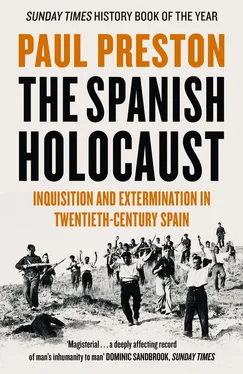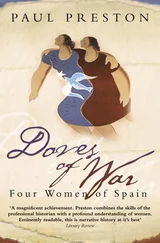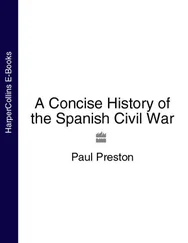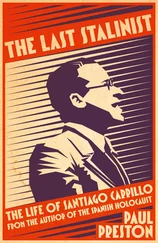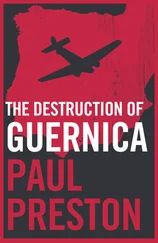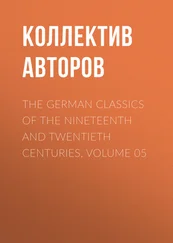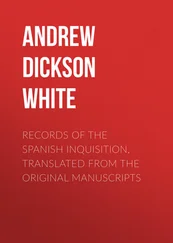Feeling vulnerable, the richest local landowners abandoned their mansions. Throughout the entire south, Republican agrarian legislation was being revived. Mixed juries returned and obligatory cultivation of fallow land was reimposed. A variant of the legislation on municipal boundaries was activated, thereby preventing the local landowners from bringing in cheap outside labour to break union action. In many villages, the restored town councils decreed that municipal employees should be given back-pay to the date when they had been deposed. Workers were assigned to estates whose owners were expected to pay them. Needless to say, the possessing classes were outraged by the perceived injustice of such measures and by the impertinence of those that they expected to be subservient and respectful. Tension was exacerbated in some villages by mayors who prohibited traditional religious processions. 45
Landowners’ resentment at the ending of peasant servility often took the form of violent assaults on union leaders. In the province of Cáceres, between February and June, nine men died at the hands either of local Falangists or of the Civil Guard. 46Right-wing violence was directed at those who were required to be submissive but were now assertively demonstrating their determination not to be cheated out of reform. In Salamanca, historically social conflict was endemic because the predominant activity of cattle-breeding required little manpower. The consequent unemployment was increased further because much arable land was also given over to hunting grounds. Although there were areas of smallholdings, to the west and south of the province, especially around Ledesma and Ciudad Rodrigo, land tenure was dominated by huge estates, the latifundios. The prospect in the spring of 1936 of a renewed push for a division of the great estates saw desperate efforts by the big landowners to block the reform. They quickly turned to violence and made contact with the military conspirators. Such was the case of Gonzalo de Aguilera, who simply shot his labourers. 47
Of the six victorious right-wing candidates in the February elections in Salamanca, Gil Robles, Cándido Casanueva, Ernesto Castaño and José Cimas Leal of the CEDA, and the Carlists José María Lamamié de Clairac and Ramón Olleros, three were implicated in soliciting the votes of the province’s wheat-growers by offering to buy up their surplus stocks. After scrutinizing the results, the committee on electoral validity, the Comisión de Actas, disqualified three, Castaño, Lamamié de Clairac and Olleros, and gave their parliamentary seats to the candidates with the next highest number of votes. Right-wing seats in Granada were also disqualified because of blatant electoral falsification. Claiming to be the target of persecution, the CEDA’s deputies withdrew en masse from the Cortes – although its value as a pulpit of propaganda saw them return quickly. The President of the Cortes, the conservative Republican Diego Martínez Barrio, believed that the right-wing reaction to the loss of the fraudulently gained seats heralded a turn to violence. Castaño, a prominent landowner, went to Valladolid, the headquarters of the VII Military Region to which Salamanca belonged, to advocate a military rising against the Republic. 48Gil Robles was in touch directly with General Mola while his faithful deputy, Cándido Casanueva, acted as the CEDA liaison with Generals Goded and Fanjul. 49Gonzalo de Aguilera may have been an extreme case, yet he was anything but an unrepresentative figure of the Salamanca landowning class.
Another local landowner, Diego Martín Veloz, was equally active in seeking military aid. He had tried hard to persuade the officers of the Salamanca garrison to join Sanjurjo’s coup in August 1932. The swarthy, pistol-toting Martín Veloz had been born in Cuba in 1875. He served as a soldier in the Philippines and Cuba and had been frequently arrested for violent indiscipline. After being invalided out of the army, he had returned penniless to the area to the east of Salamanca known as La Armuña. In the provincial capital, he had earned a living as a street vendor of items ranging from contraband watches to sheep. He had been a bouncer in a casino until he killed a client in a fight. His luck turned when he discovered an aptitude for gambling. Having made a fortune in Monte Carlo, he bought land and buildings in Salamanca. Investing in gambling and prostitution, he became the key figure in the brothels, casinos and gambling dens of Salamanca, Valladolid, Zamora and Palencia. He invested his profits in property and made a fortune, becoming one of the richest men in Salamanca. He owned a large area of the provincial capital and came to be known as ‘The boss [el amo] of Salamanca’. His antics ranged from the infantile, such as once breaking up a Corpus Christi procession by unleashing a string of donkeys into its midst, to the bloody, killing several men in gunfights. On one occasion, finding an army officer destitute in the street, he entered a gambling den and at gunpoint took up a collection for the unfortunate wretch. On another, refused entry to a club, he set off fireworks around the door. 50
First in Santander and later in Salamanca, he acquired a reputation as a thug. He was tried for murder in Santander and was absolved only after numerous senior military figures spoke on his behalf. This imposing, not to say gargantuan, figure was famous for his voracious appetites, both gastronomic and sexual. For a time fabulously rich, and wildly open-handed, Martín Veloz had cultivated friends in the military, inviting them to orgiastic parties at his estate in La Armuña, and paying off their debts. He was as notorious for the violence of his temper as he was for his generosity to his friends. Among his cronies were Generals Primo de Rivera, Queipo de Llano and Goded and Gonzalo de Aguilera. When the government began to close down his casinos, he built a political base, buying the newspaper La Voz de Castilla and creating the Farmers and Cattle-Breeders League, a party with widespread support throughout the province. His political factotum was Cándido Casanueva, the notary who was his link to Gil Robles. It was claimed that Martín Veloz bought votes for Casanueva, just as it was later alleged that Casanueva bought votes for Gil Robles. Martín Veloz’s own power base was Peñaranda de Bracamonte, east of Salamanca. 51
As a powerful cacique, he had secured a parliamentary seat in 1919 and had been involved in numerous violent incidents in the Cortes. He threatened other deputies, including Indalecio Prieto, and once drew a gun on a rival from Salamanca. After the dictator Primo de Rivera had closed down casinos and gambling dens, Martín Veloz suffered financial difficulties and faced bankruptcy by the time the Second Republic was established. Nevertheless, he remained in contact with his military friends and during the Sanjurjada vainly tried to get the Salamanca garrison to rise. In the spring of 1936, he and Cándido Casanueva collaborated with the local military in the preparation of the uprising. In particular, Martín Veloz went to great lengths to persuade his friend Gonzalo Queipo de Llano to take part. He invited him to his estate at the end of May 1936 and harangued him on the need for a coup. Moreover, when the war began, Martín Veloz, like other landowners of Salamanca, would put enormous energy into recruiting peasants for the rebel forces. 52
In the province of Toledo, violence was kept under control by the Civil Governor, who ordered the Civil Guard not to shoot unless under attack. He also ordered the confiscation of all firearms and 10,000 shotguns were collected. This well-intentioned measure was severely damaging to the peasantry, who relied on their shotguns for hunting. The guns that were kept in Civil Guard posts were either destroyed or distributed to rightists when the military coup took place. 53On 9 March, in Escalona in the north-west of Toledo, local Falangists shot four Socialist landworkers and wounded twelve more. On 5 March, in Quintanar de la Orden in the south of the province, thugs in the pay of the local cacique assaulted the house of the Socialist Mayor and pistol-whipped his wife and two small sons. They then tried to kill his elder daughter by throwing her down a well. In neither case were the perpetrators arrested. 54
Читать дальше
